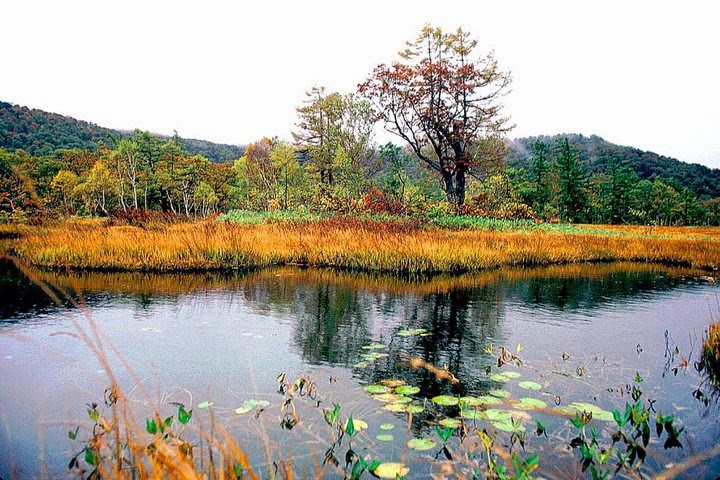Before heading to Oze National Park, numerous people told me to mentally prepare myself to share it with the hordes. It was a holiday, it was hiking season, it was a super popular destination, etc, etc. Funny that last part as I'd never even heard about it until a month ago when my friend's suggested hiking there as a counterpart to visiting her family in Fukushima. Oze? What's that? Turns out Oze is Japan's largest highland marsh, sprawling over the three prefectures of Fukushima, Gunma and Niigata.
Even with everybody telling me otherwise, the marsh grass starting to turn a beautiful reddish gold (the grass really was that colour, not photo shopped at all), and the fact that it was during a 5 day holiday, I just had a feeling that it wouldn't be crowded. Nobody believed me of course, but as you can see from the pictures, my intuition ended up being correct in the end. Now I just need to get a feeling about the numbers in the next lottery. Fall comes early at this elevation! No doubt the crowds will start picking up in the coming weeks.
Every trail in Oze is made of very nicely designed wooden boards and bridges, an admittedly impressive, and no doubt expensive feat of engineering considering there is no road access anywhere near the park, and that these trails go pretty much everywhere for miles and miles. Stepping off the trail is a no-no as the delicate balance of nature needs to be protected! I'm not sure that these well constructed wooden walkways full of rusty nails are really doing the ecosystem a whole lot of good, but I suppose it's the thought that counts, and it does help keep people away from certain areas, and provide access through the marsh in the spring when it's muddy. Not only that, it made the walk incredibly easy and comfortable, which is definitely not a bad thing.
To properly appreciate Oze, you really need a couple of days, maybe even three. The park is huge and there's no way you're going to be satisfied with a day trip from Tokyo. From Fukushima, I stayed overnight at a Japanese inn, then headed out to the park the next morning at dawn. Even with an early morning start right next to the entrance, I only got to see a frustrating 20% of the park. There was a much more massive marsh area (compared to the one you can see in these pictures) a few hours hike away (see the map at the end of this post, the massive marsh being on the left) that I didn't have time to go to.
Oze has a whole plethora of flower viewing times throughout the spring and summer. You can find flower viewing schedules telling you the exact weeks for this and that flower to be blooming. Peak times are in the spring, which is when the Japanese skunk cabbage (lovely image there) blooms, and the end of summer for the yellow alpine lily. If you're a flower fan and like your national parks to be as crowded as Disneyland, you won't be disappointed. Flowers are not really my thing though, and I'm happy to leave them to others. Except in cases like the picture below. What the heck is this thing? It wasn't listed in any of Oze's flower guides. Anybody know? Looks good enough to eat though.
One trail wound around this fairly large lake, which was the trail we ended up taking. The lake is completely inaccesible though, well at least you're not supposed to touch it. No swimming, no boating, no fishing, etc. The fish and ducks in Japan never had it so good. One wonders why they don't all come here. In the distance, the peak hidden in clouds, is Hiuchigatake, the highest mountain in northwestern Japan at 2356 meters. When I arrived at the Fukushima entrance lodge (only accessible by shuttle bus or taxi) it was drizzling slightly, but as soon as we started hiking the rain stopped, and held off for the rest of the day. I also had intuition about the weather too. Am I good or what? Sure it was still grey and cloudy, but the air was fresh and cool, perfect hiking weather in truth.
When I arrived at the Fukushima entrance lodge (only accessible by shuttle bus or taxi) it was drizzling slightly, but as soon as I have started hiking the rain stopped, and held off for the rest of the day. I also had intuition about the weather too. Am I good or what? Sure it was still grey and cloudy, but the air was fresh and cool, perfect hiking weather in truth. You can see the trail we took on the map below, and the much larger marsh on the left side (green area). Actually this is only a small percent of the whole park. It extends quite a ways north, west and south.
To give an idea of distances and walking times, my route at a fairly leisurely pace took a good 5 hours with a few breaks thrown in. Of all the hikes I've done so far, Oze has definitely been the best in terms of scenery, walkability, and uncrowdedness. I'll definitely be heading back again to check out the parts that I missed the first time. When? Well I'd better not say here, I don't want to give the crowds any ideas...
























